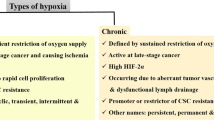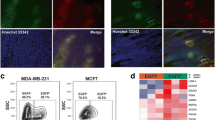Abstract
Purpose
Hypoxia has been found to play an important role in regulating the biological characteristics of cancer stem cells (cCSCs). In this study, we tested whether a tumor hypoxic niche serves to the chemotherapeutic resistance of colon cCSCs.
Methods
Each of 23 fresh samples of human colon adenocarcinoma was transplanted into nude mice. The tumor-bearing mice randomly and equally received (A) saline, (B) 5-fluorouracil (15 mg/kg), (C) oxaliplatin (10 mg/kg), and (D) oxaliplatin plus 5-fluorouracil when xenografts reached 250 mm3 (n = 10). After 2-week treatment, tumor cells were quantified by flow cytometry for expression of CD133 and the hypoxic proportion of CD133+ and CD133− cells which were also sorted and detected for ki67 and pimonidazole via immunofluorescence.
Results
The hypoxic subpopulation of CD133+ and CD133− cells was 66.5 and 26.4 %, respectively. Although there was no marked change for the hypoxic subpopulation of CD133+ cells after treatment, the hypoxic fraction of proliferative CD133+ cells was increased by 14.62, 16.45, and 20.46 % in groups B, C, and D, respectively. Furthermore, proliferative cells in CD133+ and CD133− cells were reduced by 29.93 and 62.5 % in group C, and by 25.26 and 68.22 % in group D; in group B, however, the proliferative CD133+ cells were increased by 37.09 %; the CD133− cells were unchanged.
Conclusions
Most CD133+ cCSCs are located in a hypoxic niche, where cCSCs are better at retaining proliferating property under chemotherapy. Oxaliplatin, rather than 5-FU, inhibits proliferation of cCSCs, which may be the mechanism underlying a better outcome by oxaliplatin in colon cancer patients.







Similar content being viewed by others
References
Axelson H, Fredlund E, Ovenberger M, Landberg G, Pahlman S (2005) Hypoxia-induced dedifferentiation of tumor cells—a mechanism behind heterogeneity and aggressiveness of solid tumors. Semin Cell Dev Biol 16(4–5):554–563
Bapat SA, Mali AM, Koppikar CB, Kurrey NK (2005) Stem and progenitor-like cells contribute to the aggressive behavior of human epithelial ovarian cancer. Cancer Res 65(8):3025
Bonnet D, Dick JE (1997) Human acute myeloid leukemia is organized as a hierarchy that originates from a primitive hematopoietic cell. Nat Med 3(7):730–737
Brown JM (2007) Tumor hypoxia in cancer therapy. Methods Enzymol 435:295–321
Brown JM, Giaccia AJ (1998) The unique physiology of solid tumors: opportunities (and problems) for cancer therapy. Cancer Res 58(7):1408
Calabrese C, Poppleton H, Kocak M, Hogg TL, Fuller C, Hamner B, Oh EY, Gaber MW, Finklestein D, Allen M (2007) A perivascular niche for brain tumor stem cells. Cancer Cell 11(1):69–82
Collins A, Berry P, Hyde C, Stower M, Maitland N (2005) Prospective identification of tumorigenic prostate cancer stem cells. Cancer Res 65(23):10946–10951. doi:10.1158/0008-5472.CAN-05-2018
Comerford KM, Wallace TJ, Karhausen J, Louis NA, Montalto MC, Colgan SP (2002) Hypoxia-inducible factor-1-dependent regulation of the multidrug resistance (MDR1) gene. Cancer Res 62(12):3387
Covello KL, Kehler J, Yu H, Gordan JD, Arsham AM, Hu CJ, Labosky PA (2006) HIF-2alpha regulates Oct-4 effects of hypoxia on stem cell function embryonic development and tumor growth. Genes Dev 20(5):557–570
Dean M, Fojo T, Bates S (2005) Tumour stem cells and drug resistance. Nat Rev Cancer 5(4):275–284
Dontu G, El-Ashry D, Wicha MS (2004) Breast cancer, stem/progenitor cells and the estrogen receptor. Trends Endocrinol Metab 15(5):193–197
Genbacev O, Zhou Y, Ludlow JW, Fisher SJ (1997) Regulation of human placental development by oxygen tension. Science 277(5332):1669
Goethals L, Debucquoy A, Perneel C, Geboes K, Ectors N, De Schutter H, Penninckx F, McBride WH, Begg AC, Haustermans KM (2006) Hypoxia in human colorectal adenocarcinoma: comparison between extrinsic and potential intrinsic hypoxia markers. Int J Radiat Oncol Biol Phys 65(1):246–254
Gustafsson MV, Zheng X, Pereira T, Gradin K, Jin S, Lundkvist J, Ruas JL, Poellinger L, Lendahl U, Bondesson M (2005) Hypoxia requires notch signaling to maintain the undifferentiated cell state. Dev Cell 9(5):617–628
Hamburger AW, Salmon SE (1977) Primary bioassay of human tumor stem cells. Science 197(4302):461–463
Harris AL (2002) Hypoxia-A key regulatory factor in tumour growth. Nat Rev Cancer 2(1):38–47
Hermann PC, Bhaskar S, Cioffi M, Heeschen C (2010) Cancer stem cells in solid tumors. Semin Cancer Biol 20(2):77–84
Horst D, Kriegl L, Engel J, Kirchner T, Jung A (2008) CD133 expression is an independent prognostic marker for low survival in colorectal cancer. Br J Cancer 99(8):1285–1289
Jemal A, Siegel R, Xu J, Ward E (2010) Cancer statistics. CA Cancer J Clin 60(5):277–300
Keith B, Simon MC (2007) Hypoxia-inducible factors, stem cells, and cancer. Cell 129(3):465–472
Krishnamurthy P, Ross DD, Nakanishi T, Bailey-Dell K, Zhou S, Mercer KE, Sarkadi B, Sorrentino BP, Schuetz JD (2004) The stem cell marker Bcrp/ABCG2 enhances hypoxic cell survival through interactions with heme. J Biol Chem 279(23):24218
LaBarge MA, Bissell MJ (2008) Is CD133 a marker of metastatic colon cancer stem cells? J Clin Investig 118(6):2021
Levesque JP, Winkler IG, Hendy J, Williams B, Helwani F, Barbier V, Nowlan B, Nilsson SK (2007) Hematopoietic progenitor cell mobilization results in hypoxia with increased hypoxia-inducible transcription factor-1 alpha and vascular endothelial growth factor A in bone marrow. Stem Cells 25(8):1954–1965. doi:10.1634/stemcells.2006-0688
Li Z, Bao S, Wu Q, Wang H, Eyler C, Sathornsumetee S, Shi Q, Cao Y, Lathia J, McLendon RE (2009) Hypoxia-inducible factors regulate tumorigenic capacity of glioma stem cells. Cancer Cell 15(6):501–513
Meyerhardt JA, Mayer RJ (2005) Systemic therapy for colorectal cancer. N Engl J Med 352(5):476–487
Moore KA, Lemischka IR (2006) Stem cells and their niches. Science 311(5769):1880
Nishi H, Nakada T, Kyo S, Inoue M, Shay JW, Isaka K (2004) Hypoxia-inducible factor 1 mediates upregulation of telomerase (hTERT). Mol Cell Biol 24(13):6076
O’Brien CA, Pollett A, Gallinger S, Dick JE (2006) A human colon cancer cell capable of initiating tumour growth in immunodeficient mice. Nature 445(7123):106–110
Olive P, Durand R, Raleigh J, Luo C, Aquino-Parsons C (2000) Comparison between the comet assay and pimonidazole binding for measuring tumour hypoxia. Br J Cancer 83(11):1525
Omura K (2008) Advances in chemotherapy against advanced or metastatic colorectal cancer. Digestion 77(1):13–22
Pardal R, Clarke MF, Morrison SJ (2003) Applying the principles of stem-cell biology to cancer. Nat Rev Cancer 3(12):895–902
Parmar K, Mauch P, Vergilio JA, Sackstein R, Down JD (2007) Distribution of hematopoietic stem cells in the bone marrow according to regional hypoxia. Proc Nat Acad Sci 104(13):5431
Platet N, Liu SY, Atifi ME, Oliver L, Vallette FM, Berger F, Wion D (2007) Influence of oxygen tension on CD133 phenotype in human glioma cell cultures. Cancer Lett 258(2):286–290
Pouyssegur J, Dayan F, Mazure NM (2006) Hypoxia signalling in cancer and approaches to enforce tumour regression. Nature 441(7092):437–443
Reya T, Morrison SJ, Clarke MF, Weissman IL (2001) Stem cells, cancer, and cancer stem cells. Nature 414(6859):105–111
Ricci-Vitiani L, Lombardi DG, Pilozzi E, Biffoni M, Todaro M, Peschle C, De Maria R (2006) Identification and expansion of human colon-cancer-initiating cells. Nature 445(7123):111–115
Seidel S, Garvalov BK, Wirta V, Von Stechow L, Schänzer A, Meletis K, Wolter M, Sommerlad D, Henze AT, Nistér M (2010) A hypoxic niche regulates glioblastoma stem cells through hypoxia inducible factor 2α. Brain 133(Pt 4):983–995
Semenza GL (2009) Defining the role of hypoxia-inducible factor 1 in cancer biology and therapeutics. Oncogene 29(5):625–634
Shmelkov SV, Butler JM, Hooper AT, Hormigo A, Kushner J, Milde T, Clair RS, Baljevic M, White I, Jin DK (2008) CD133 expression is not restricted to stem cells, and both CD133+ and CD133− metastatic colon cancer cells initiate tumors. J Clin Investig 118(6):2111
Singh S, Hawkins C, Clarke I, Squire J, Bayani J, Hide T, Henkelman R (2004) Identification of human brain tumor initiating cells. Nature 432(7015):396–401. doi:10.1038/nature03031
Todaro M, Alea MP, Di Stefano AB, Cammareri P, Vermeulen L, Iovino F, Tripodo C, Russo A, Gulotta G, Medema JP (2007) Colon cancer stem cells dictate tumor growth and resist cell death by production of interleukin-4. Cell Stem Cell 1(4):389–402
Yin T, Li L (2006) The stem cell niches in bone. J Clin Investig 116(5):1195
Acknowledgments
This work was supported by National Natural Science Fund of China (30870734, 81172131); “The 12th Five-year plan” for Technology Platform Construction of Innovative Drug Research and Development of China (2011ZX09302-001); The National Basic Research 550 Program of China( 2007CB947802).
Conflict of interest
We declare that we have no conflict of interest.
Author information
Authors and Affiliations
Corresponding authors
Additional information
Qin Mao and Yu Zhang contributed equally to this work.
Rights and permissions
About this article
Cite this article
Mao, Q., Zhang, Y., Fu, X. et al. A tumor hypoxic niche protects human colon cancer stem cells from chemotherapy. J Cancer Res Clin Oncol 139, 211–222 (2013). https://doi.org/10.1007/s00432-012-1310-3
Received:
Accepted:
Published:
Issue Date:
DOI: https://doi.org/10.1007/s00432-012-1310-3




